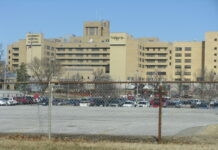Photo credit: DiasporaEngager (www.DiasporaEngager.com).
Tammy E. Servies, MD1; Eric C. Larsen, MD1; Rodney C. Lindsay, MPH1; Jonathan S. Jones, MS1; Regina Z. Cer, MS2; Logan J. Voegtly, MS2,3; Matthew R. Lueder, MS2,3; Francisco Malagon, PhD2,3; Kimberly A. Bishop-Lilly, PhD2; Asha J. Riegodedios, MSPH4 (View author affiliations)
View suggested citation
On July 27, 2021, a fully vaccinated* crew member on a U.S. Navy ship who had been symptomatic with cough and congestion for 4 days was evaluated in the ship’s onboard medical department and received a positive test result† for SARS-CoV-2, the virus that causes COVID-19. The ship had approximately 350 personnel on board§; COVID-19 vaccination rate was >98%.¶ The ship had been on an 8-week deployment with port visits in Norway (July 13–14) and in Reykjavik, Iceland (July 18–21). Masking and physical distancing mandates on the ship were relaxed while at sea but were immediately reimplemented upon identification of the crew member’s positive test result. During the deployment, personnel had permission to go ashore only during the Iceland port visit and only if they were fully vaccinated. Before July 27, no one had been evaluated at the onboard medical department for respiratory symptoms. Although reported COVID-19 incidence was low in Iceland just before the port visit (17.5 per 100,000 population on July 18), incidence increased approximately elevenfold, to 219.5 per 100,000 on July 27 with emergence of the B.1.617.2 (Delta) variant.** At the onset of the COVID-19 pandemic, outbreaks on some U.S. Navy ships led to attack rates greater than 25% (1) of the crew in the confined environment. In this outbreak during Delta variant predominance, the combination of a high vaccination rate with prevention strategies resulted in a lower (6.3%) attack rate of COVID-19 than seen at the onset of the pandemic.
After identification of the initial case on July 27, all ship personnel were notified to report to the onboard medical department if they had any COVID-19–like signs or symptoms,†† resulting in diagnoses of an additional 11 COVID-19 cases that day. The ship immediately instituted prevention measures, including mask use, physical distancing, increased cleaning, isolation of the 12 initial patients, testing of 69 close contacts,§§ and testing and quarantine of six unvaccinated persons (two of whom were also close contacts). On July 28 and 29, six additional cases were identified through testing. Nasal swabs from these 18 persons with positive antigen test results were sent off the ship for reverse transcription–polymerase chain reaction (RT-PCR) testing and all were positive for SARS-CoV-2.¶¶ Further analysis determined 17 of the 18 specimens were Delta variant AY.9 lineage; 16 of the 17 were identical.*** During this same time frame at the end of July, Delta AY.9 was identified in 8% of specimens in Iceland and fewer than 1% of specimens in Norway and the United States.††† The 18 infected persons were removed from the ship on July 31 to reduce the ship’s health care requirements and to prevent further transmission. Four additional cases of COVID-19 were identified during August 1–7 (including three diagnosed aboard the ship and one postdeployment) with onset July 28–August 5. The overall attack rate was 6.3%. The ship returned to its home port on August 3, concluding its deployment as scheduled.
Among the 22 infected personnel identified, all were fully vaccinated, and all were symptomatic. Most (91%) were aged <40 years (average age = 30.2 years). No patient required hospitalization or supplemental oxygen and no deaths occurred. Before the outbreak was identified on July 27, 13 (59%) of the 22 infected personnel had been symptomatic for a median of 3 days (range = 1–5 days) aboard the ship with no masking or physical distancing protocols in place (Figure). During the 15-day outbreak period (July 22–August 5), 91 personnel received rapid antigen testing.
Only one case was identified >14 days after the Iceland port visit, demonstrating very limited spread of infection despite exposure to symptomatic personnel for a median of 3 days in the confined shipboard spaces. In previous U.S. Navy shipboard outbreaks, before COVID-19 vaccines were available, SARS-CoV-2 spread was rapid and extensive, with attack rates of 26.6% (1,271 of 4,779 personnel) on one ship (1) and 36.3% (121 of 333) on another (Navy and Marine Corps Public Health Center, unpublished data, 2020). These attack rates were approximately four and six times higher, respectively, than that described in this report.
The findings in this report are subject to at least four limitations. First, shipboard testing was limited to rapid antigen testing, which has a lower sensitivity than RT-PCR testing in asymptomatic persons (2). Second, testing relied on persons to report symptoms and close contacts, which is subject to recall bias. Third, this was an outbreak of Delta variant and findings might not be applicable to B.1.1.529 (Omicron) or other variant outbreaks. Finally, this outbreak occurred in a highly vaccinated, young, healthy population, thus limiting generalizability to the overall U.S. population.
This outbreak in the enclosed environment of a ship suggests that high vaccination rates, in combination with COVID-19 prevention measures, can substantially reduce the spread of SARS-CoV-2, despite the high transmissibility of the Delta variant and introduction of SARS-CoV-2 into a congregate setting. Infections among vaccinated persons did occur, which is expected (3), but symptoms were mild. Vaccination, in coordination with multicomponent prevention strategies, are critical to limiting SARS-CoV-2 transmission and COVID-19–related illness.
MMWR and Morbidity and Mortality Weekly Report are service marks of the U.S. Department of Health and Human Services.
Use of trade names and commercial sources is for identification only and does not imply endorsement by the U.S. Department of
Health and Human Services.
References to non-CDC sites on the Internet are
provided as a service to MMWR readers and do not constitute or imply
endorsement of these organizations or their programs by CDC or the U.S.
Department of Health and Human Services. CDC is not responsible for the content
of pages found at these sites. URL addresses listed in MMWR were current as of
the date of publication.
All HTML versions of MMWR articles are generated from final proofs through an automated process.
This conversion might result in character translation or format errors in the HTML version.
Users are referred to the electronic PDF version (https://www.cdc.gov/mmwr)
and/or the original MMWR paper copy for printable versions of official text, figures, and tables.
Questions or messages regarding errors in formatting should be addressed to
mmwrq@cdc.gov.
Source of original article: Centers for Disease Control and Prevention (CDC) / MMWR (Journal) (tools.cdc.gov).
The content of this article does not necessarily reflect the views or opinion of Global Diaspora News (www.GlobalDiasporaNews.com).
To submit your press release: (https://www.GlobalDiasporaNews.com/pr).
To advertise on Global Diaspora News: (www.GlobalDiasporaNews.com/ads).
Sign up to Global Diaspora News newsletter (https://www.GlobalDiasporaNews.com/newsletter/) to start receiving updates and opportunities directly in your email inbox for free.





























